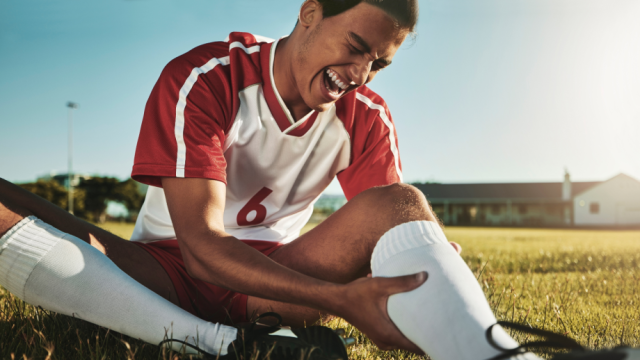
Don't let the pain of shin splints sideline your game
Don't want injuries this season, take a splint second to learn how to prevent them.
'Clear'ing up Shin Splints
Shin splints are an overuse or repetitive load injury, affecting the front of the tibia. This pain is felt along the front of your lower leg, at the shin bone. This pain is in the area where the bone meets the muscles that surround it.

Soccer players are at risk for shin splits when training intensity and length of practice increase along with using the wrong footwear. Individuals with fallen arches or flat feet are also more at risk. Each of these factors can result in excess stress, inflammation, and tears on the bone tissue supporting the bone, resulting in pain.
Dribbling through the Pain
Running in soccer can also impact and increase shin splints due to the constant hustle, sudden stops, and changes in direction when playing. These movements can further strain the muscles and tissues around the shin area, causing and contributing to the development of shin splints.
Kickstarting Recovery
With any injury, you need to treat both the symptoms and the cause of the injury to reduce the potential of reinjuring it. Here are some tips for reducing the pain and reoccurrence of shin splints:
Icing and Anti-Inflammatories
Start by icing the shin and taking an anti-inflammatory which should help calm down the initial inflammation. Proper icing techniques can be found here.
Modify Activity
Modify activity for a few weeks after symptoms arise by reducing practice time or intensity. If players can switch temporarily to a lower-impact exercise such as biking or swimming, it will help eliminate pounding stress on the leg, while still getting cardio in. Before each game and practice, warm up the lower leg by stretching to reduce the potential for shin splints.
Wear Supportive Footwear
Wear supportive, properly fitted footwear when not in soccer cleats. If the shoes are not properly fit for your feet, it can cause calluses, blisters, and other foot issues that can cause severe deformities and injuries. The wrong shoes can also mess with how your body lines up and how you walk.
Shin guards are great soccer and shin splint tools as well. While they provide a layer of protection for the shin area, they do not directly prevent shin splints. However, if you already have shin splints, shin guards are a great tool to release the firey pressure from shin splints as well as help them heal faster.
.png)
Seek Medical Evaluation
Once the initial shin splint pain calms down it is helpful to identify the cause of the shin splint injury with a specialist. OrthoCarolina's Sports Medicine and Foot & Ankle specialists are ready to help and same-day appointments are available at a number of locations. Schedule an appointment with our foot and ankle team today.
If you're uncertain of whether the pain you're experiencing is shin splint-related or something else, download the HURT! App, powered by OrthoCarolina, for quick free access to orthopedic specialists. in the case of shin splints.
Kickin' Back and Stretching
Here are some effective stretches to help relieve shin sprint pressure:
Heel Raises
- Stand with your feet hip-width apart and flat on the ground.
- Slowly raise your heels off the ground as high as you can. Hold onto the wall or a chair for support.
- Hold the raised position for a few seconds.
- Lower your heels back down to the starting position.
Towel Stretch
- Sit on the floor with one leg stretched out in front of you.
- Loop a towel around your toes and the ball of your foot.
- Pull the towel toward your body with both hands, keeping your knee straight.
- Hold this position for 15 to 30 seconds.
- Relax.
- Repeat three times.
Shin muscle stretch
- Sit in a chair, with both feet flat on the floor.
- Bend your affected leg behind you so that the top of your foot is flat on the floor and your toes are pointed. You can hold on to the sides of the chair for support.
- Hold this position for 15 to 30 seconds. You should feel a stretch in your shin.
- Repeat two to four times.

Combining these stretches with the advice and tips for managing shin splints can help you get back on track and stay in the game pain-free. Remember, taking care of your body and addressing the causes of injuries is key to long-term success on and off the field.
This information is provided as an educational service and is not intended to serve as medical advice. If you are seeking specific orthopedic advice or assistance, please consult with your OrthoCarolina physician or locate one in your area through OrthoCarolina’s website at www.OrthoCarolina.com.
Back




Leave a Comment